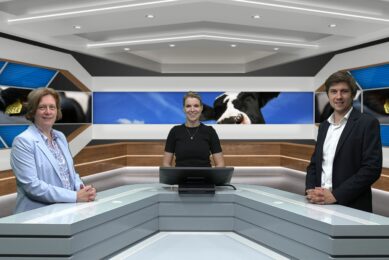Webinar on demand: Sustainable Dairy Farming

Did you catch this recent webinar on Sustainable Dairy farming? If not, watch our 3 experts present valuable insights on the topic – it’s now available on demand and at no cost.
This webinar, hosted by Dairy Global, was in cooperation with Trouw Nutrition and Novonesis and took place on 25 April. The line-up of speakers during the webinar presented their insights on the topics below:
Phil Garnsworthy, emeritus professor of dairy science, University of Nottingham
Presentation: Improving carbon balance on dairy farms
Professor Garnsworthy looked at rumen methane, manure management, feed carbon footprint and energy on the farm. “If we start looking at the feed carbon footprint, then each feed on the farm has a different carbon footprint,” he adds. He touched on the feed carbon footprint of low-cost diets – grazed grass, grass silage, maize silage and by-products.
Garnsworthy also looked at land use and land use change and highlighted grasslands sequestration of carbon and showed that arable land is a net emitter of carbon, especially if not deep peat soil. “Permanent grassland and improved grasslands sequester carbon,” he noted, adding, “When we talk about land use change, we are talking about changing from one crop to another – if we change from grassland to forest then there is a net release of carbon; if we change from grassland to crops then there is a much bigger release of carbon…”
Dr Garnsworthy noted that the importance of carbon sequestration is mainly overlooked because of a lack of data. He further referenced the carbon footprint of milk production per litre of milk in a study that looked at systems in Ireland, the UK and the US. Watch his presentation for this and more.
Ainhoa Perojo Gutierrez, head of animal segments, commercial development APHN,
Novonesis
Presentation: The role of biosolutions at farm level
Ainhoa Perojo Gutierrez from Novonesis (a merger between Chr Hansen and Novozymes), is a leading enzymes producer globally. She piqued the interest of the audience in terms of what biosolutions can do at farm level. “We want to bring biosolutions that are respectful of the environment with sustainability parameters, but also that brings profitability to industry.”
She talked about farm challenges like feed spoilage, improved feed efficiency, reduction of waste, optimal use of resources, sustainability etc., and addressed these with biosolutions. Gutierrez highlighted that sustainable dairy farming addresses the ‘Triple bottom line’ – reduction of emissions, animal welfare and natural resources. “Sustainability should not come at a cost; it should come with profitability,” she said.
Under the umbrella of sustainability she highlighted that biosolutions can address strategies like optimal use of resources, improve feed efficiency and secure good gut health in livestock. She discussed probiotics as well as silage inoculents in her presentation and referenced the effects of a Bacillus-based probiotic, Bovacillus, on the performance of dairy cows to support gut health.
In her presentation she also spoke about how silage inoculants can support sustainability on-farm: “A good silage inoculent – like SiloSolve FC – will bring you more quality and more nutrients, and will also impact production.” For more, watch her presentation.
Dr Liz Homer, sustainability manager, ruminants ECA, Trouw Nutrition
Presentation: A holistic approach to sustainability from calf to 5th lactation and beyond
Dr Homer discussed sustainable systems, what contributes to carbon footprint, links between efficiency and sustainability, and how to reduce the carbon footprint. “No one system is the most sustainable – for example, grazed vs all year-round housing…but all systems can be marginally sustainable.” She looked at what makes up the carbon footprint per kg of Fat and Protein Corrected Milk (FPCM), from energy to feed and highlighted the importance of rearing and feeding youngstock properly and unlocking genetic potential from early on at the calf stage.
She referenced a study in which she showed that “with every 100g of average daily gain in the first 2 months of life, you can expect approximately 225kg of extra milk in the first lactation.” Homer also pointed out the impact of age of first calving on footprint and profitability in terms of less feed, higher milk production and fewer animals, which leads to a lower footprint.
Feed efficiency was also a topic in her discussion, as well as looking at how silage quality influences footprint, pointing to details of an analysis of forage quality of top 20% and bottom 20% forages analysed by Trouw Nutrition GB Laboratory. “You can see the huge impact we can have through livestock and rearing your calves properly, looking after the transition period, looking at replacement rates and fertility, going into precision nutrition and looking at the specific footprint of the compound feed. There are lots of things we can do today – marginal improvements can lead to big gains,” she said. Watch her discussion.
Join 13,000+ subscribers
Subscribe to our newsletter to stay updated about all the need-to-know content in the dairy sector, two times a week.










